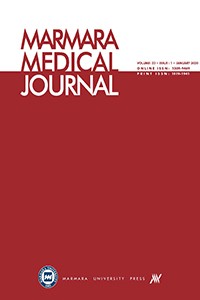Ventricular tachycardia ablation in patients with structural heart disease: single centre experience
Öz
Objective: We intended to report our institutional experience with ventricular tachycardia (VT) ablation in patients with structural heart disease.
Patients and Methods: A total of 36 consecutive patients (31 male, age: 62.8 ± 13.2 years) who had undergone VT ablation in our institution between 01.01.2017 and 01.05.2019 were included in the analysis.
Results: A total of 27 patients with the diagnosis of ischemic cardiomyopathy and 9 patients with the diagnosis of nonischemic cardiomyopathy had undergone VT ablation. VT ablation was successful in 32 (88.9%) patients. There were no major procedural complications; however, one patient with ischemic cardiomyopathy died 48 hours after the procedure because of post-ablation cardiogenic shock. Another patient with unsuccessful VT ablation died during hospitalization due to electrical storm. Endocardial ablation was performed in 23 (63.9%) patients and epicardial or combined endocardial and epicardial ablation was performed in 13 (36.1%) patients. Substrate ablation was the dominant strategy in 29 (80.6%) patients whereas activation mapping and isthmus ablation was performed in 7 (19.4%) patients.
Conclusion: Our experience confirms the effectiveness and safety of VT ablation in patients with structural heart disease who are resistant to medical therapy and/or who receive recurrent implantable cardioverter-defibrillator shocks.
Anahtar Kelimeler
Ventricular tachycardia Radiofrequency ablation Cardiomyopathies
Kaynakça
- [1] Ponikowski P, Voors AA, Anker SD, et al. 2016 ESC Guidelines for the diagnosis and treatment of acute and chronic heart failure The Task Force for the diagnosis and treatment of acute and chronic heart failure of the European Society of Cardiology (ESC) Developed with the special contribution of the Heart Failure Association (HFA) of the ESC. Eur Heart J 2016; 37: 2129-200. doi: 10.1093/eurheartj/ehw128.
- [2] Dukkipati SR, Koruth JS, Choudry S, Miller MA, Whang W, Reddy VY. Catheter ablation of ventricular tachycardia in structural heart disease: Indications, strategies, and outcomes – part II. J Am Coll Cardiol 2017; 70: 2924-41. doi: 10.1016/j. jacc.2017.10.030.
- [3] Sapp JL, Wells GA, Parkash R, et al. Ventricular tachycardia ablation versus escalation of antiarrhythmic drugs. N Engl J Med 2016; 375: 111-21. doi: 10.1056/NEJMoa1513614.
- [4] Reddy VY, Reynolds MR, Neuzil P, et al. Prophylactic catheter ablation for the prevention of defibrillator therapy. N Engl J Med 2007; 357: 2657-65. doi: 10.1056/NEJMoa065457.
- [5] Kuck KH, Schaumann A, Eckardt L, et al. Catheter ablation of stable ventricular tachycardia before defibrillator implantation in patients with coronary heart disease (VTACH): a multicentre randomised controlled trial. Lancet 2010; 375: 3140. doi: 10.1016/S0140-6736(09)61755-4.
- [6] Kuck KH, Tilz RR, Deneke T, et al. Impact of substrate modification by catheter ablation on implantable cardioverterdefibrillator interventions in patients with unstable ventricular arrhythmias and coronary artery disease: results from the multicenter randomized controlled SMS (Substrate Modification Study). Circ Arrhythm Electrophysiol 2017; 10: e004422. doi: 10.1161/CIRCEP.116.004422
- [7] Tung R, Vaseghi M, Frankel DS, et al. Freedom from recurrent ventricular tachycardia after catheter ablation is associated with improved survival in patients with structural heart disease: An International VT Ablation Center Collaborative Group study. Heart Rhythm 2015; 12: 1997-2007. doi: 10.1016/j.hrthm.2015.05.036
- [8] Di Biase L, Burkhardt JD, Lakkireddy D, et al. Ablation of stable VTs versus substrate ablation in ischemic cardiomyopathy: The VISTA Randomized Multicenter Trial. J Am Coll Cardiol 2015; 66: 2872-82. doi: 10.1016/j.jacc.2015.10.026.
- [9] Okubo K, Gigli L, Della Bella P. Catheter ablation of ventricular tachycardia in nonischemic cardiomyopathy. J Arrhythm 2018; 34: 347-55. doi: 10.1002/joa3.12099.
Öz
Kaynakça
- [1] Ponikowski P, Voors AA, Anker SD, et al. 2016 ESC Guidelines for the diagnosis and treatment of acute and chronic heart failure The Task Force for the diagnosis and treatment of acute and chronic heart failure of the European Society of Cardiology (ESC) Developed with the special contribution of the Heart Failure Association (HFA) of the ESC. Eur Heart J 2016; 37: 2129-200. doi: 10.1093/eurheartj/ehw128.
- [2] Dukkipati SR, Koruth JS, Choudry S, Miller MA, Whang W, Reddy VY. Catheter ablation of ventricular tachycardia in structural heart disease: Indications, strategies, and outcomes – part II. J Am Coll Cardiol 2017; 70: 2924-41. doi: 10.1016/j. jacc.2017.10.030.
- [3] Sapp JL, Wells GA, Parkash R, et al. Ventricular tachycardia ablation versus escalation of antiarrhythmic drugs. N Engl J Med 2016; 375: 111-21. doi: 10.1056/NEJMoa1513614.
- [4] Reddy VY, Reynolds MR, Neuzil P, et al. Prophylactic catheter ablation for the prevention of defibrillator therapy. N Engl J Med 2007; 357: 2657-65. doi: 10.1056/NEJMoa065457.
- [5] Kuck KH, Schaumann A, Eckardt L, et al. Catheter ablation of stable ventricular tachycardia before defibrillator implantation in patients with coronary heart disease (VTACH): a multicentre randomised controlled trial. Lancet 2010; 375: 3140. doi: 10.1016/S0140-6736(09)61755-4.
- [6] Kuck KH, Tilz RR, Deneke T, et al. Impact of substrate modification by catheter ablation on implantable cardioverterdefibrillator interventions in patients with unstable ventricular arrhythmias and coronary artery disease: results from the multicenter randomized controlled SMS (Substrate Modification Study). Circ Arrhythm Electrophysiol 2017; 10: e004422. doi: 10.1161/CIRCEP.116.004422
- [7] Tung R, Vaseghi M, Frankel DS, et al. Freedom from recurrent ventricular tachycardia after catheter ablation is associated with improved survival in patients with structural heart disease: An International VT Ablation Center Collaborative Group study. Heart Rhythm 2015; 12: 1997-2007. doi: 10.1016/j.hrthm.2015.05.036
- [8] Di Biase L, Burkhardt JD, Lakkireddy D, et al. Ablation of stable VTs versus substrate ablation in ischemic cardiomyopathy: The VISTA Randomized Multicenter Trial. J Am Coll Cardiol 2015; 66: 2872-82. doi: 10.1016/j.jacc.2015.10.026.
- [9] Okubo K, Gigli L, Della Bella P. Catheter ablation of ventricular tachycardia in nonischemic cardiomyopathy. J Arrhythm 2018; 34: 347-55. doi: 10.1002/joa3.12099.
Ayrıntılar
| Birincil Dil | İngilizce |
|---|---|
| Konular | Klinik Tıp Bilimleri |
| Bölüm | Original Research |
| Yazarlar | |
| Yayımlanma Tarihi | 31 Ocak 2020 |
| Yayımlandığı Sayı | Yıl 2020 Cilt: 33 Sayı: 1 |


